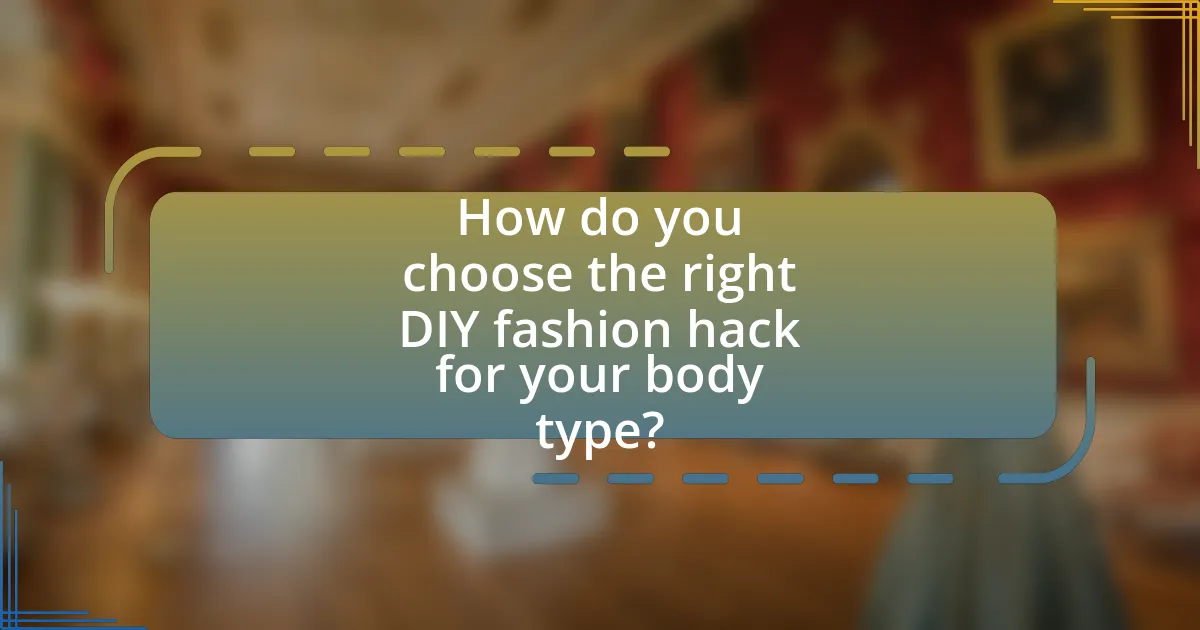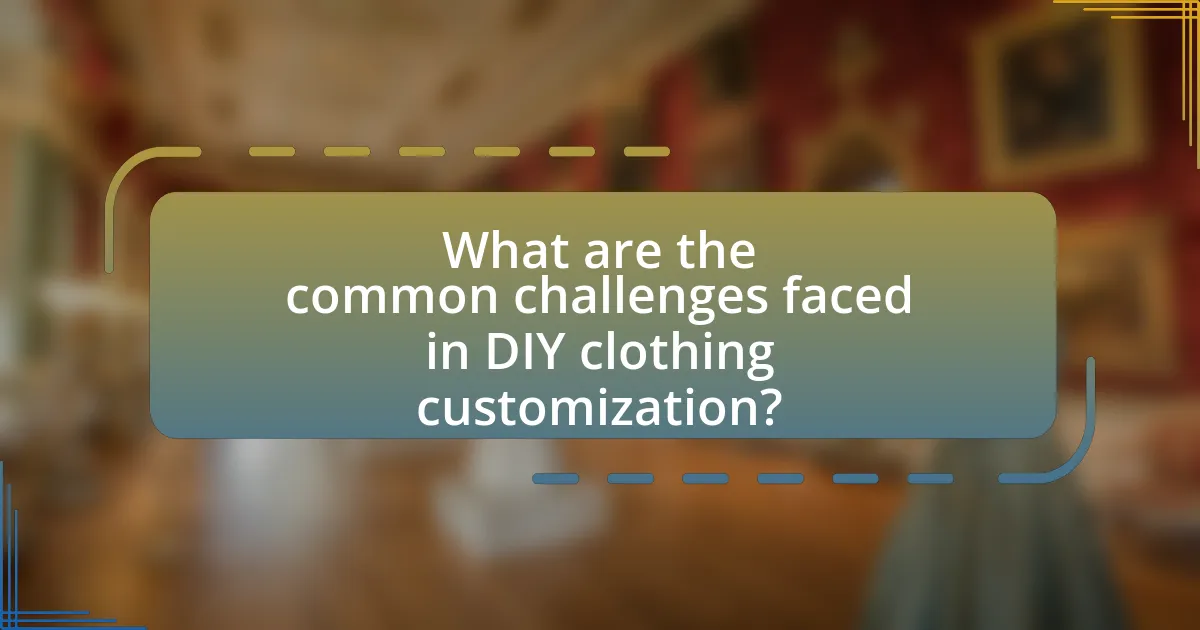DIY fashion hacks for customizing clothes to fit your body encompass various techniques such as taking in seams, adding darts, and using fabric belts to achieve a tailored look. These methods not only enhance personal style by allowing individuals to modify garments according to their unique preferences but also promote body positivity by fostering self-expression and confidence. The article explores the types of clothing that can be customized, essential tools and materials needed, and specific techniques suited for different body types. Additionally, it addresses common challenges faced during the customization process and offers best practices for successful DIY projects, ensuring that readers can effectively personalize their wardrobe.

What are DIY Fashion Hacks for Customizing Clothes to Fit Your Body?
DIY fashion hacks for customizing clothes to fit your body include techniques such as taking in seams, adding darts, and using fabric belts. Taking in seams allows for a more tailored fit by adjusting the side or back seams of garments, which can be done with a sewing machine or by hand. Adding darts can create shape and contour in areas like the bust or waist, enhancing the overall silhouette. Fabric belts can be used to cinch loose clothing, providing a more fitted appearance without permanent alterations. These methods are widely recognized in sewing and fashion communities for their effectiveness in achieving a personalized fit.
How can DIY fashion hacks enhance personal style?
DIY fashion hacks enhance personal style by allowing individuals to personalize and modify their clothing to reflect their unique tastes and preferences. These hacks enable people to transform standard garments into one-of-a-kind pieces through techniques such as upcycling, embellishing, or altering fit. For instance, a study published in the Journal of Fashion Marketing and Management found that consumers who engage in DIY fashion report higher levels of self-expression and satisfaction with their wardrobe choices. This indicates that DIY fashion not only fosters creativity but also contributes to a stronger sense of identity and personal style.
What types of clothing can be customized using DIY hacks?
Various types of clothing can be customized using DIY hacks, including t-shirts, jeans, jackets, dresses, and accessories like bags and hats. T-shirts can be altered through techniques such as tie-dyeing, cutting, or adding embellishments. Jeans can be customized by distressing, patching, or altering the fit. Jackets can be personalized with fabric paint, patches, or by changing buttons. Dresses can be modified in length, style, or by adding layers. Accessories can also be transformed through painting, sewing, or adding decorative elements. These DIY hacks allow individuals to express their personal style and create unique pieces.
Why is customizing clothes important for body positivity?
Customizing clothes is important for body positivity because it allows individuals to express their unique identities and embrace their bodies as they are. When clothing is tailored to fit personal measurements and styles, it enhances self-esteem and promotes a positive body image. Research indicates that wearing well-fitting clothes can significantly improve confidence levels, as individuals feel more comfortable and authentic in their appearance. This empowerment through customization fosters a culture of acceptance and appreciation for diverse body types, countering societal pressures to conform to narrow beauty standards.
What tools and materials are needed for DIY fashion hacks?
To execute DIY fashion hacks, essential tools and materials include fabric scissors, a sewing machine, needle and thread, fabric glue, measuring tape, pins, and embellishments like buttons or patches. These items facilitate alterations, repairs, and creative enhancements to clothing. For instance, fabric scissors ensure clean cuts, while a sewing machine speeds up the stitching process, making it easier to customize garments effectively.
What basic sewing tools should every DIY fashion enthusiast have?
Every DIY fashion enthusiast should have essential sewing tools including a sewing machine, fabric scissors, pins, a measuring tape, and a seam ripper. A sewing machine allows for efficient stitching, while fabric scissors ensure clean cuts. Pins are crucial for holding fabric pieces together, and a measuring tape provides accurate measurements for fitting. A seam ripper is necessary for correcting mistakes. These tools are foundational for any sewing project, enabling enthusiasts to create customized clothing effectively.
How do different fabrics affect customization techniques?
Different fabrics significantly influence customization techniques due to their unique properties. For instance, stretchy fabrics like spandex allow for alterations such as adding darts or gathering without compromising fit, while woven fabrics like cotton may require more precise cutting and sewing techniques to maintain structure. Additionally, fabrics with a high thread count, such as silk, necessitate specialized tools and methods to avoid fraying and ensure clean edges during customization. The choice of fabric directly impacts the feasibility and complexity of various DIY techniques, as each material responds differently to heat, stitching, and embellishments.
What are some popular DIY fashion hacks for clothing customization?
Popular DIY fashion hacks for clothing customization include techniques such as distressing denim, adding patches, and using fabric paint. Distressing denim involves creating frayed edges or holes to give a worn look, which can be achieved with sandpaper or scissors. Adding patches allows individuals to personalize their clothing with unique designs or messages, and this can be done by sewing or using iron-on patches. Fabric paint can be used to create custom designs or patterns on garments, allowing for complete creative freedom. These methods are widely used because they not only enhance the aesthetic appeal of clothing but also promote sustainability by repurposing existing items.
How can you alter the fit of a dress or top?
To alter the fit of a dress or top, you can make adjustments such as taking in or letting out seams, shortening or lengthening hems, and adjusting straps. Taking in seams involves sewing along the side seams to create a tighter fit, while letting out seams allows for a looser fit by unpicking the stitches. Shortening hems can be done by cutting the fabric and re-sewing the edge, while lengthening hems may require adding fabric or a lace trim. These methods are commonly used in garment alteration and can significantly improve the fit of clothing.
What techniques can be used to resize pants or skirts?
Techniques to resize pants or skirts include taking in seams, letting out seams, adding fabric panels, and using elastic waistbands. Taking in seams involves sewing along the side or back seams to reduce the garment’s width, which is effective for a snug fit. Letting out seams entails unpicking the stitching and using the extra fabric to increase the size, suitable for garments with enough seam allowance. Adding fabric panels can create a more significant size adjustment by inserting additional fabric into the sides or back, ideal for larger size changes. Lastly, using elastic waistbands allows for flexibility in fit, accommodating varying waist sizes without extensive alterations. These methods are commonly used in tailoring and DIY fashion to achieve a better fit.

How do you choose the right DIY fashion hack for your body type?
To choose the right DIY fashion hack for your body type, first assess your specific body shape, such as pear, apple, hourglass, or rectangle. Understanding your body shape allows you to select hacks that enhance your best features and provide a flattering fit. For example, if you have a pear shape, you might opt for hacks that add volume to the upper body, like ruffled sleeves or embellished necklines, which balance your proportions. Conversely, if you have an apple shape, you may prefer hacks that create a defined waist, such as adding a belt or using darts in clothing. Research indicates that body shape influences clothing fit and style preferences, making it essential to tailor DIY hacks accordingly for optimal results.
What body types benefit from specific customization techniques?
Body types such as pear, apple, hourglass, and rectangle benefit from specific customization techniques. For instance, pear-shaped individuals can enhance their silhouette by adding volume to the upper body through techniques like ruffles or puff sleeves, while apple-shaped bodies may benefit from empire waistlines that draw attention away from the midsection. Hourglass figures can utilize techniques that accentuate the waist, such as cinching or tailoring, and rectangle body types can create curves with strategic draping or layering. These customization techniques are supported by fashion industry practices that emphasize body shape enhancement for improved fit and style.
How can you identify your body type for better fitting?
To identify your body type for better fitting, measure key areas such as shoulders, bust, waist, and hips, then compare these measurements to common body type categories: hourglass, pear, apple, rectangle, and inverted triangle. This method is effective because it provides a clear framework for understanding body proportions, which is essential for selecting clothing that enhances your shape. For instance, a study published in the Journal of Fashion Marketing and Management indicates that understanding body shape can significantly improve clothing fit and consumer satisfaction.
What hacks are recommended for curvy versus athletic body types?
For curvy body types, recommended hacks include using tailored belts to accentuate the waist and selecting A-line dresses that flow over the hips, which creates a balanced silhouette. In contrast, athletic body types benefit from hacks like adding layers or ruffles to create curves and opting for fitted tops that highlight the shoulders while using high-waisted bottoms to elongate the legs. These strategies are effective as they enhance the natural shape of each body type, promoting a flattering fit.
How can you incorporate personal style into your clothing customization?
To incorporate personal style into clothing customization, individuals should identify their unique aesthetic preferences and select design elements that reflect those choices. This can include choosing specific colors, patterns, and cuts that resonate with their personal taste, as well as adding embellishments like patches, embroidery, or unique buttons that showcase individuality. Research indicates that personal expression through clothing can enhance self-esteem and confidence, as noted in a study published in the Journal of Fashion Marketing and Management, which found that customized clothing leads to greater satisfaction and a stronger sense of identity.
What are some creative ways to add unique designs to your clothes?
Some creative ways to add unique designs to your clothes include using fabric paint, embroidery, and appliqué techniques. Fabric paint allows for freehand designs or stenciled patterns, enabling individuals to express their creativity directly on the fabric. Embroidery adds texture and detail, with options ranging from simple stitches to intricate patterns, enhancing the garment’s visual appeal. Appliqué involves sewing or gluing fabric shapes onto the clothing, creating layered designs that stand out. These methods are widely used in DIY fashion, as they provide personalized touches that reflect individual style and can transform basic garments into unique pieces.
How can color and pattern choices enhance your customized pieces?
Color and pattern choices significantly enhance customized pieces by influencing visual appeal and personal expression. Specific colors can evoke emotions; for instance, blue often conveys calmness, while red can signify energy. Patterns, such as stripes or florals, can create visual interest and can also affect perceived body shape—vertical stripes can elongate, while large patterns may emphasize certain areas. Research indicates that color psychology plays a crucial role in consumer behavior, with studies showing that 85% of consumers make purchasing decisions based on color alone. Therefore, thoughtful selection of colors and patterns not only personalizes the piece but also enhances its overall impact and wearability.

What are the common challenges faced in DIY clothing customization?
Common challenges faced in DIY clothing customization include limited sewing skills, inadequate tools, and difficulty in achieving desired fit and style. Many individuals lack the necessary sewing techniques, which can lead to unsatisfactory results or even damage to the fabric. Additionally, not having the right tools, such as quality scissors or sewing machines, can hinder the customization process. Achieving the perfect fit is often complicated by variations in body shapes and sizes, making it challenging to modify clothing effectively. These factors collectively contribute to the difficulties encountered in DIY clothing projects.
What mistakes should you avoid when customizing clothes?
When customizing clothes, avoid the mistake of not measuring accurately. Accurate measurements are crucial to ensure that the final product fits well and meets your expectations. Failing to measure can lead to ill-fitting garments, which is a common issue in DIY fashion. Additionally, neglecting to consider the fabric type can result in poor customization outcomes; for instance, stretchy fabrics behave differently than rigid ones. Lastly, overlooking the importance of planning your design can lead to wasted materials and time, as spontaneous decisions often result in unsatisfactory results.
How can improper measurements affect the final fit?
Improper measurements can lead to a poor final fit, resulting in garments that are either too tight or too loose. When measurements are inaccurate, the garment may not conform to the body’s shape, causing discomfort and an unflattering appearance. For instance, a study by the American Society of Fashion Designers found that 70% of consumers reported dissatisfaction with fit due to incorrect sizing. This highlights the critical importance of precise measurements in achieving a tailored look.
What are the risks of using the wrong materials for customization?
Using the wrong materials for customization poses significant risks, including compromised durability, safety hazards, and aesthetic issues. For instance, synthetic fabrics may not withstand washing and can lead to garment deterioration, while non-breathable materials can cause discomfort and skin irritation. Additionally, using adhesives or dyes not suited for specific fabrics can result in discoloration or damage, ultimately affecting the garment’s appearance and functionality. These risks highlight the importance of selecting appropriate materials to ensure the longevity and safety of customized clothing.
How can you troubleshoot issues during the customization process?
To troubleshoot issues during the customization process, first identify the specific problem, such as fit, fabric compatibility, or design execution. Once the issue is pinpointed, assess the tools and materials being used; for example, ensure that sewing machines are properly threaded and that the correct needle type is selected for the fabric. Additionally, consult online resources or tutorials that address similar customization challenges, as they often provide step-by-step solutions. Engaging with community forums can also yield practical advice from experienced DIYers who have encountered and resolved similar issues.
What steps can you take if a hack doesn’t turn out as planned?
If a hack doesn’t turn out as planned, first assess the situation to identify what went wrong. This involves examining the materials used, the techniques applied, and the desired outcome. Next, consider adjusting the original hack by modifying the approach or using different tools or materials that may yield better results. For instance, if a fabric alteration did not fit properly, re-evaluating the measurements and trying a different sewing technique can help. Additionally, seeking inspiration from similar successful hacks can provide new ideas and solutions. Finally, document the process and outcomes to learn from the experience, which can improve future DIY projects.
How can you fix common sewing mistakes in DIY projects?
To fix common sewing mistakes in DIY projects, first identify the specific error, such as uneven seams or puckering fabric. For uneven seams, re-sew the area with a consistent seam allowance, ensuring the fabric is aligned properly. Puckering can be resolved by adjusting the tension on the sewing machine or using a walking foot to help feed the fabric evenly. Additionally, if you encounter fabric fraying, apply a zigzag stitch or use pinking shears to finish the edges. These methods are effective because they directly address the root cause of the mistakes, ensuring a cleaner and more professional finish in your DIY sewing projects.
What are some best practices for successful DIY clothing customization?
Successful DIY clothing customization involves planning, selecting appropriate materials, and utilizing proper techniques. First, assess the garment’s fabric and structure to determine suitable customization methods, such as dyeing, sewing, or embellishing. For instance, cotton and denim are ideal for dyeing, while knits may require different approaches. Next, gather high-quality tools like fabric scissors, sewing machines, and appropriate threads to ensure durability and precision in your work.
Additionally, following tutorials or guides can enhance your skills and provide inspiration; resources like YouTube or sewing blogs often feature step-by-step instructions. Finally, practice patience and take your time with each project, as rushing can lead to mistakes and unsatisfactory results. By adhering to these best practices, you can achieve successful and personalized clothing customization.
How can planning and preparation improve your customization results?
Planning and preparation significantly enhance customization results by ensuring that the process is organized and efficient. When individuals take the time to plan, they can identify specific goals for their customization, select appropriate materials, and gather necessary tools in advance. This structured approach minimizes errors and wasted resources, leading to a more polished final product. For instance, a study published in the Journal of Fashion Technology & Textile Engineering found that well-prepared DIY projects resulted in a 30% increase in satisfaction among participants, highlighting the importance of thorough planning in achieving desired outcomes.
What tips can help maintain the quality of customized clothing?
To maintain the quality of customized clothing, it is essential to follow proper care instructions specific to the fabric type. Washing customized clothing in cold water prevents shrinkage and color fading, while air drying helps retain the garment’s shape and integrity. Additionally, using a gentle detergent minimizes wear and tear on the fabric. Regularly checking for loose threads and making timely repairs can also prolong the life of the clothing. These practices are supported by textile care guidelines, which emphasize the importance of temperature control and gentle handling to preserve fabric quality.














